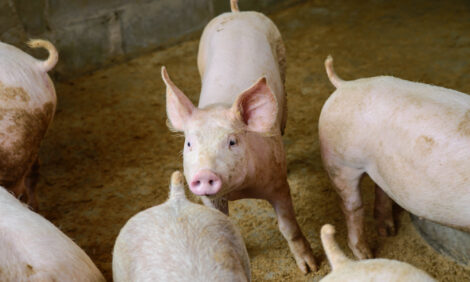



CME: H1N1 in Pigs No Surprise to US Pork Industry
US - USDA confirmed yesterday that a pig exhibited at last month’s Minnesota State Fair had novel H1N1 influenza — the influenza strain also called “swine“ flu, write Steve Meyer and Len Steiner in their Daily Livestock Report for 20 October.This marks the first US pig that has been found to have the novel H1N1 virus. Influenzas are
common in pigs and pig producers worldwide deal with influenzas every year, usually in the fall and winter months when hog barns are
closed up tighter to maintain optimal temperatures. The symptoms are the same for pigs as they are for people — congestion, coughing,
sneezing, aches and a fever. Some producers will administer antibiotics during an influenza incident in order to prevent secondary bacterial
infections. Antibiotics are not effective on viruses. Most pig recover in just a few days much as people do.
This case was discovered as part of a research project funded by the Centers for Disease Control and carried out by researchers
from the University of Iowa and the University of Minnesota to monitor influenza. They did not suspect that pigs at the Minnesota fair had
H1N1 but several students who stayed in a nearby dormitory during the fair were diagnosed with the virus later. USDA said that nothing
suggested that the children got the virus from the pigs. Our contacts say that the reverse (pigs got the virus from the children) is much more
likely. Pigs had been found to have novel H1N1 in several other countries since the influenza strain first appeared in Mexico last winter.
This finding is no surprise to the US pork industry. Producers, veterinarians and government officials have been preparing for
this day for some time. The circumstance of this finding is, if anything, positive in that the pigs were from a youth project, not a larger
commercial population and the infection is in the past, not the present. We understand that neither the pig not its owner can be identified
because the samples are not identified as part of the research protocol. The pig was apparently not sick at the time or it would not have been
allowed into a slaughter facility.
Perhaps the most reassuring news was the reaction of futures markets yesterday. CME Group Lean Hogs contracts were mixed
with most months spending part of the day as both gainers and losers. CME Group Lean Hogs futures were lower today and one cannot
rule out this finding’s playing some role in that but there were a number of technical factors that impacted the markets today as well. Most
pork industry observers have been pleased that wholesale pork prices have not been harmed by the increased news coverage that H1N1 influenza
has received this fall after schools re-convened and more and more cases were identified. It appears that the message that pork is
safe and that people cannot get H1N1 from pork is being heard.
One feature of CME Lean Hogs futures that many traders find beneficial is that the contracts are cash settled. There is no
physical delivery to settle open positions. All open positions at contract expiration are closed using the CME Lean Hog Index which is a
two-day weighted average of the volume-weighted average of USDA’s weighted average prior-day net price for negotiated and swine/pork
market formula trades. The USDA volumes, weights and prices come from the National Daily Direct Hog Prior Day Report—Slaughtered
Swine, available by clicking here.

The computation procedure is spelled out in the CME Rulebook, Chapter 152. As can be seen above, the Index quite logically tracks these two cash hog markets very closely. As a two-day average it smoothes the series a bit with the Index highs being lower and the Index lows being higher than the underlying data. This cash settlement procedure has been used since the Live Hogs contract was switched to the carcass-weight Lean Hogs contract in February 1997. Cash settlement positives include lower costs and long specs not having to worry about owning a load of pigs in Sioux City, Iowa or at some other delivery point someday. The biggest negative is that cash settlement forces convergence on only the last two days of the contract’s life. Basis levels are still reasonably predictable in the three to four weeks prior to contract month expiration but non-contract months have posed some severe basis challengers for hedgers from time to time.








